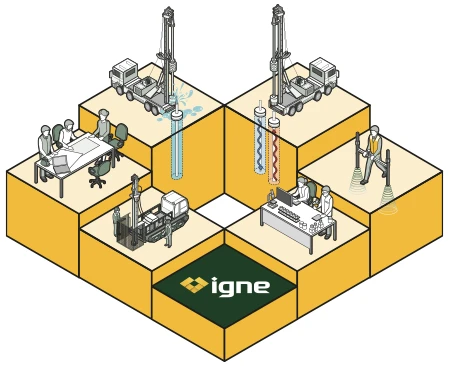

River Cross & Long Sections Surveys: Accurate Profiling of Riverbeds & Flow Dynamics
River cross and long sections surveys are specialised bathymetric surveys that provide detailed profiles of a riverbed's shape and depth.
About
What are River Cross & Long Sections Surveys?
Cross section surveys measure the depth and contours of a river across its width, while long section surveys chart the river's depth along its length.
Together, these surveys offer a comprehensive view of the underwater terrain, helping stakeholders understand the flow characteristics, sediment transport, and structural integrity of the riverbed.
These surveys are crucial for projects related to river management, flood control, and infrastructure development, as they deliver precise data about the river’s current conditions and help predict changes over time.
Conducted using advanced sonar equipment, unmanned surface vehicles (USVs) total stations & GNSS, river cross and long section surveys allow for accurate mapping even in difficult-to-access areas.

Useage
Why are River Cross & Long Sections Surveys Useful, and for Whom?
River cross and long sections surveys are vital for various industries and professionals, as they provide the data needed to make informed decisions about the use, management, and protection of river systems.
Flood Risk Management
Flood risk managers and local authorities rely on these surveys to assess river capacity, flow rates, and potential flood hazards. By understanding the shape and profile of the riverbed, stakeholders can predict how water levels will rise during heavy rainfall or snowmelt, enabling more effective flood prevention strategies.
Infrastructure Development
Engineers and construction teams working on bridges, culverts, dams, or riverbank stabilisation projects use these surveys to evaluate the suitability of a riverbed for construction. The detailed data helps to ensure that structures are built on stable ground, reducing the risk of erosion or structural failure.
Environmental Monitoring & Conservation
Environmental scientists and conservationists use river cross and long sections surveys to monitor changes in riverbed morphology, sediment transport, and habitat conditions. This information is critical for protecting biodiversity, preventing erosion, and ensuring sustainable river management.
Waterway Navigation & Safety
Navigational authorities use these surveys to ensure safe passage for boats and vessels by identifying underwater hazards such as sandbars, rocks, or debris that could impede navigation or cause accidents
Trust
Why Choose Igne for River Cross & Long Sections Surveys?
At Igne, we are experts in bathymetric and geotechnical surveying, providing professional services that minimise risk and maximise project success. Our team has extensive experience in conducting river cross and long sections surveys using the latest technology, including high-resolution sonar and USV systems, to ensure the most accurate and reliable results.
When you commission Igne for your river cross or long sections survey, you can trust that we will deliver data tailored to your project’s specific needs. Whether you’re developing flood defences, planning an infrastructure project, or monitoring environmental changes, our surveys will provide the insights you need to make informed, confident decisions.
Our commitment to quality, precision, and client satisfaction means that we work closely with you to ensure that our surveys not only meet your requirements but also exceed your expectations.
With Igne, you’re choosing a partner dedicated to delivering solutions that de-risk your project and provide lasting value.
Risks
The Risks of Not Conducting River Cross or Long Sections Surveys
Skipping river cross and long sections surveys can lead to serious consequences that can impact both the safety and success of a project.
Flooding & Erosion
Without a thorough understanding of a river’s profile, flood risk models can be incomplete or inaccurate. This could result in ineffective flood defences, leaving surrounding areas vulnerable to flooding and erosion.
Structural Failure
Infrastructure projects that do not incorporate river cross and long sections data risk building on unstable or unsuitable ground. This increases the likelihood of erosion, undermining, or structural collapse, which could lead to costly repairs or project delays.
Environmental Harm
Without proper monitoring, changes in river morphology may go unnoticed, leading to erosion, sediment build-up, or habitat degradation. This can have long-term negative effects on biodiversity and the health of aquatic ecosystems.
Navigational Hazards
Failing to survey riverbeds thoroughly can leave hazards such as submerged debris or shallow areas undetected. This increases the risk of accidents or damage to vessels navigating the waterway.
Benefits
The Benefits of River Cross & Long Sections Surveys
River cross and long sections surveys offer numerous advantages that go beyond basic data collection, supporting the safety, efficiency, and environmental sustainability of projects.
Accurate, Detailed Data
These surveys provide high-resolution profiles of the riverbed, allowing for precise planning and decision-making. Whether you need to assess flood risk or develop infrastructure, the data provided is essential for mitigating risks and ensuring project success.
Cost-Effective Solutions
By identifying potential issues early in the project lifecycle, river cross and long sections surveys help prevent costly delays, redesigns, or failures. Accurate data minimises the risk of errors, saving time and money in the long run.
Environmental Protection
These surveys support sustainable river management by providing critical information about riverbed conditions, erosion patterns, and sediment transport. This helps protect habitats and preserve biodiversity while minimising human impact on the environment.
Improved Safety
For projects involving navigation or waterway management, these surveys identify hazards that could impede boat traffic or pose a risk to vessels. This ensures safer navigation and reduces the likelihood of accidents.
Technology
What Equipment is Used for River Cross & Long Sections Surveys?
River cross and long sections surveys utilise state-of-the-art equipment to ensure accurate and reliable results:
Sonar Systems
Sonar technology is used to measure the depth and contours of the riverbed. The system sends sound waves to the riverbed and measures the time it takes for them to return, creating detailed profiles of the underwater terrain.
GPS & Geospatial Mapping
GPS systems are used to accurately track the location of the survey equipment, ensuring that all data is georeferenced for precise mapping and analysis.
Unmanned Surface Vehicles (USVs)
USVs equipped with sonar and GPS systems are deployed to navigate the river, collecting data efficiently and safely, even in difficult-to-access areas.
Process
How are River Cross & Long Sections Surveys Conducted?
Conducting river cross and long sections surveys involves four key steps to ensure comprehensive and accurate data collection:
- Survey Planning
The first step is to plan the survey, defining the areas of the river to be profiled and selecting the appropriate equipment. The flight or navigation paths of the USV are determined based on the project’s specific requirements. - Data Collection
The USV, equipped with sonar and GPS, is deployed to collect bathymetric data along the cross sections (across the width) and long sections (along the length) of the river. The sonar system measures water depth and riverbed contours, while the GPS ensures precise positioning of the collected data. - Data Processing
Once collected, the bathymetric data is processed using specialised software to create detailed profiles of the riverbed. These profiles are analysed to assess river capacity, flow characteristics, and potential hazards. - Analysis & Reporting
The processed data is reviewed by Igne’s experts, who generate comprehensive reports that include detailed cross and long section profiles. These reports provide actionable insights for flood risk management, infrastructure planning, or environmental conservation efforts.
Learn More
Frequently Asked Questions about River Cross & Long Sections Surveys
- What is the difference between cross and long section surveys?
Cross section surveys measure the depth and profile of a river across its width, while long section surveys map the riverbed along its length.
- Why are river cross and long sections important for flood risk management?
These surveys provide detailed data on the river’s capacity, flow dynamics, and sedimentation patterns, which are essential for accurate flood modelling and the design of effective flood defences.
- What types of projects benefit from river cross and long sections surveys?
Projects involving flood risk management, infrastructure development (such as bridges and dams), environmental monitoring, and waterway navigation benefit from these surveys.
- How accurate are river cross and long sections surveys?
These surveys are highly accurate due to the use of advanced sonar and GPS systems, which ensure precise measurements and georeferenced data.
- Can river cross and long sections surveys be used in shallow rivers?
Yes, USVs equipped with sonar systems can operate in both deep and shallow rivers, ensuring comprehensive data collection regardless of water depth.
The Next Step
Discover how Igne’s river cross and long sections surveys can support your project’s success.
Whether you’re planning flood defences, infrastructure, or environmental monitoring, our expert team is ready to deliver the data and insights you need.
Explore our full range of bathymetric surveys and contact us today to discuss your specific requirements.
